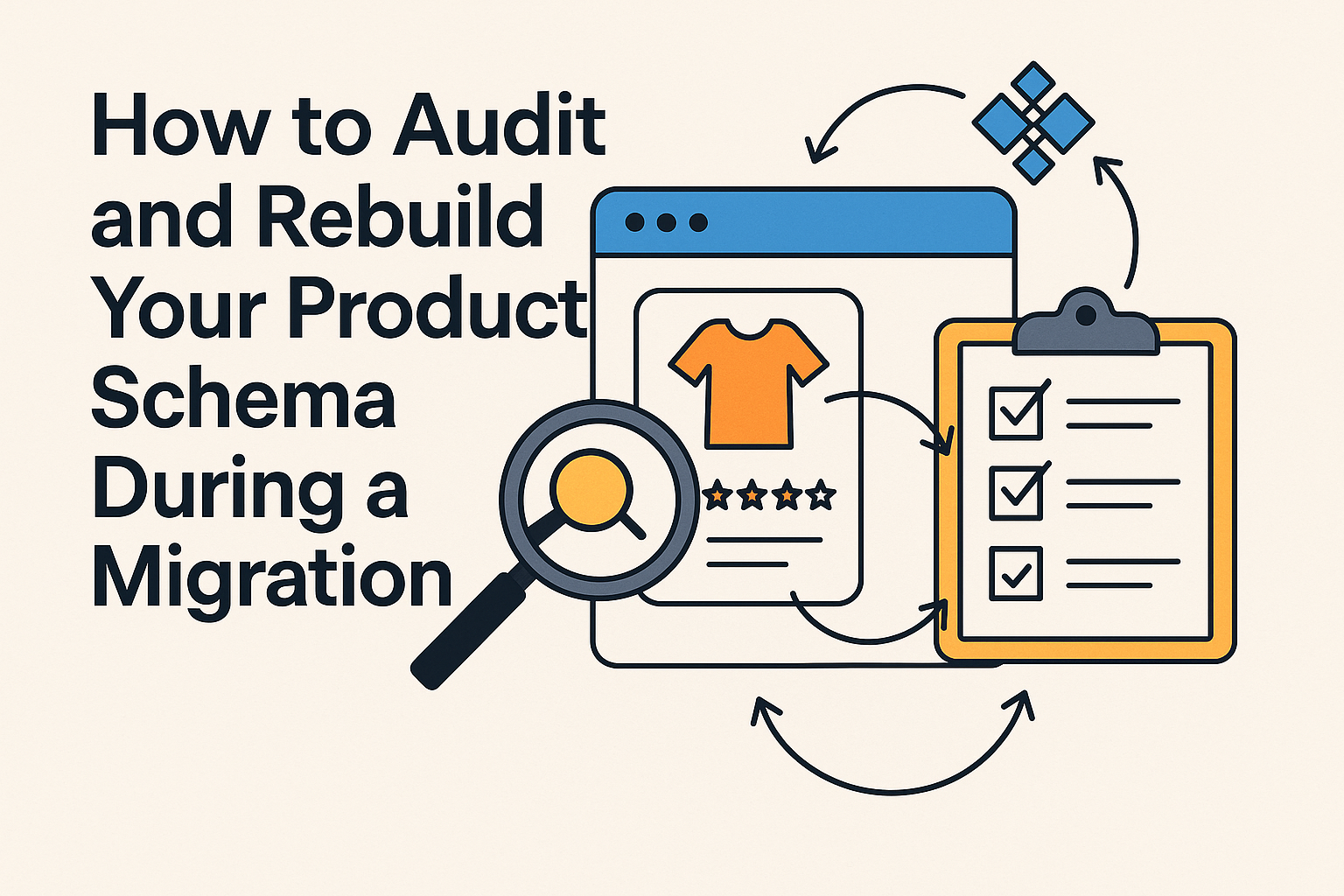How to Audit and Rebuild Your Product Schema During a Migration

Strong 8k brings an ultra-HD IPTV experience to your living room and your pocket.
When you’re planning an ecommerce migration—whether moving from Magento to Shopify, WooCommerce to BigCommerce, or custom platforms to SaaS—there’s one critical step that too many brands overlook: auditing and rebuilding the product schema.
It’s tempting to treat schema as a behind-the-scenes technical detail. But in reality, your product data structure is the backbone of your store. Poor schema during migration can lead to broken filters, SEO drops, inventory errors, and a confusing customer experience.
In this guide, we’ll walk you through how to properly audit, redesign, and migrate your product schema—ensuring your new platform is clean, scalable, and search-ready.
Whether you're handling the move in-house or working with an ecommerce website migration service, this process is non-negotiable if you care about long-term growth.
What Is a Product Schema?
A product schema is the structured data that defines the fields, types, and relationships of all your products. It’s not just about titles and prices—it includes:
- Product categories
- Variants (size, color, material)
- Attributes (gender, style, weight)
- Custom fields (engraving options, expiration dates)
- Tags, metafields, or custom taxonomies
- SEO data (meta titles, descriptions, canonical tags)
- Structured data for Google (schema.org markup)
A strong schema allows:
- Faceted filtering
- Better SEO indexing
- More efficient inventory management
- Clean data reporting
- Personalization and dynamic merchandising
And when you’re undergoing ecommerce platform migration services, you have a unique opportunity to clean and optimize this foundation.
Why Product Schema Breaks During Migration
Each ecommerce platform has its own way of handling product data. For example:
- Shopify uses “options” and “variants” with a flat structure.
- Magento supports complex, multi-attribute grouped products.
- WooCommerce relies heavily on WordPress taxonomies and custom fields.
- BigCommerce uses modifier sets and product rules.
If you blindly export and import your data without auditing the schema first, you risk:
- Losing critical product attributes
- Duplicate or inconsistent fields
- Broken variant logic (e.g., color-size combinations)
- Invalid SEO markup or missing structured data
- Filters that don’t work on the frontend
This is why any good ecommerce website migration service includes a product schema audit and rebuild in the early stages.
Step 1: Audit Your Current Product Schema
Before you migrate anything, take stock of how your data is structured today.
Key Questions to Ask:
- What attributes are global vs. specific to categories?
- Are any attributes used inconsistently across products?
- Are variants clearly defined and separated?
- Are SEO fields populated (titles, meta descriptions)?
- Are there redundant or legacy fields from previous imports?
- Is your data normalized or full of inconsistencies (e.g., “Red” vs. “red” vs. “RED”)?
💡 Tip: Export your product catalog to a spreadsheet and use pivot tables or filters to uncover patterns and inconsistencies.
Step 2: Design an Ideal Schema for the New Platform
Now that you know what you’re working with, it's time to define what you should have.
A good ecommerce platform migration services provider will help you architect a schema that’s:
- Normalized: Clean, consistent naming and value formatting
- Extensible: Supports future categories or attributes
- SEO-optimized: Structured for rich snippets and metadata
- User-friendly: Powers front-end filters and search
- Integrated: Aligns with inventory, ERP, and PIM systems
Key Design Decisions:
- Which fields will be required?
- How will variants be defined and grouped?
- What naming conventions will you follow?
- Which data will be indexed or filterable?
- How will you handle localized/language-specific fields?
This is also where you align schema decisions with business logic: product bundles, personalization options, pricing rules, and more.
Step 3: Map Old Schema to New
Once your ideal schema is defined, map each legacy field to the new format.
If you’re using an ecommerce website migration service, this step is often handled through automated scripts and ETL tools, especially for stores with thousands of SKUs.
Step 4: Clean and Normalize the Data
No matter how well your data was managed before, migrations are the perfect time to clean house.
Here’s what to do:
- Standardize attribute values (e.g., “Blue”, not “blue”, “blu”, or “Blue.”)
- Remove unused or deprecated fields
- Consolidate duplicate values
- Unify variant logic
- Flag missing critical data
You may also need to reconcile media assets, like images tied to variants, videos, or downloadable specs.
This step ensures the new store doesn't inherit old data mistakes—and that your product catalog performs well post-launch.
Step 5: Rebuild Schema in the New Platform
Now that your clean, mapped data is ready, it’s time to set up the schema in the destination platform.
Here’s how this plays out across common platforms:
- Shopify: Set up product types, options, and metafields via the admin or API. Use Shopify’s Product Taxonomy for consistency.
- BigCommerce: Define custom fields and product modifiers. Use option sets for reusable attribute groups.
- Magento: Leverage EAV attributes and assign them to attribute sets by product type.
- Headless Platforms (e.g., Commerce Layer, Swell): Define a flexible schema using APIs and GraphQL schemas.
An experienced ecommerce platform migration services partner will handle this implementation in line with best practices—ensuring scalability and compatibility with your front-end logic.
Step 6: Validate, Test, and Iterate
Never assume your migrated product data is perfect after one pass. Testing is critical.
✅ Check front-end display: Are all product attributes visible and styled correctly?
✅ Test filters and search: Can users find products by key attributes like size, price, or color?
✅ Validate SEO: Do schema.org tags render properly in structured data tools? Are canonical tags and meta titles clean?
✅ Run test orders: Are variant combinations adding correctly to cart? Are SKUs and inventory mapping correctly?
Iterate on any issues before full launch. Testing product schema should be part of your QA checklist.
Bonus: Add Enriched Structured Data
Since you’re already working on the product schema, go the extra mile and implement enriched structured data (like Product or Offer schema). This boosts SEO with:
- Review snippets
- Price and availability info
- Ratings
Google loves well-structured product data—and clean migrations are the best time to bake it in.
Final Thoughts: Clean Schema, Clean Future
Migrations are chaotic by nature. But they also offer the best chance you’ll get in years to clean up your product catalog, structure your data correctly, and build a scalable foundation.
Auditing and rebuilding your product schema isn’t just a technical task—it’s a strategic investment in better SEO, UX, merchandising, and inventory efficiency.
If you're planning a replatforming effort, make sure your ecommerce website migration service provider understands the importance of schema and has the tools to do it right. Great ecommerce performance starts with great product data.
Note: IndiBlogHub features both user-submitted and editorial content. We do not verify third-party contributions. Read our Disclaimer and Privacy Policyfor details.







